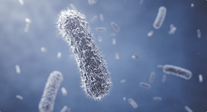
 metanogenic archaea (produce methane gas from methanol with hydrogen as the electron donor) inhabiting human gut. The balance of methanogens and other microbes within the human gut plays a role in the health and disease of the animal they inhabit. The prevalence of M. luminyensis significantly increases with age, contrary to M. smithii and M. stadtmanae. Methanomassiliicoccus luminyensis B10 is able to deplete trimethylamine (TMA), by reducing it with hydrogen for methanogenesis and was proposed to be used as treatment (archaebiotic) for metabolic disorders.
Comments
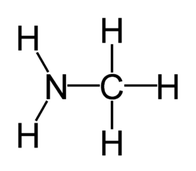 Simplest biogenic amine, derivative of ammonia with one H atom replaced by a methyl group. Has with a strong odor resembling rotten fish Methylamine and dimethylamine may be formed as metabolites of basic drugs containing N-methyl group. Can be detected in human breath and increased in certain conditions: e.g. because of amine catabolism increase in diabetes. It has been reported that transient irritation of the eyes, nose, and throat has resulted from brief exposures to MEthylamine concentrations of 20 to 100 ppm; the odor was intolerable at 100 to 500 ppm. Inhalation of methylamine vapors at concentrations greater than 100 ppm has caused irritation of the nose and throat, followed by violent sneezing, burning sensation of the throat, coughing, constriction of the larynx and difficulty in breathing, pulmonary congestion, and edema of the lungs.  Organic compound with the formula CH₂=CCOOCH₃, CAS 80–62–6 Used in n chain-addition polymerizations, in the manufacture of methacrylate resins and plastics (e.g., Plexiglas; advertising signs and displays, lighting, plumbing and bathroom fixtures; lacquer, and enamel resins; concrete additives, and prosthetic medical devices - such as hip and knee joint prostheses). It can be detected in small concentrations in human breath - Streptococcus pneumonia infections, for example, increase its concentrations up to 1420 ppb. Methyl methacrylate is a flammable and reactive chemical, fire and explosion hazard. Breathing it in can irritate the lungs causing coughing and or shortness of breath. Higher exposures can cause a build up of fluid in the lungs and pulmonary edema. It can affect liver and kidneys, damage nervous system, causing numbness, “puns and needles”, and/or weakness in the hands and feet, and may cause a skin allergy. High exposure can cause dizziness, irritability, difficulty with concentration and reduced memory. Workplace exposure limits are 100 ppm over 8 hrs shifts or 50 ppm if longer term exposures.  White opaque nutritious liquid (rich in fat and protein) secreted by mammals. Contains a diverse community of probiotics. Main bacteria in human milk are Proteobacteria and Firmicutes, including Staphylococcus (31%), Enterobacteriaceae (10%), Pseudomonas (17%), and Streptococcus (5%). Milk is one of the best sources of calcium, essential for healthy bones and teeth and a rich source of potassium. A glass of milk a day' may delay knee osteoarthritis in women. Calcium and lactose have been suggested to prevent ovarian cancer. Research also supports a relationship between higher intakes of calcium and reduced risks of colorectal cancer, but the results of studies have not always been consistent. The acidifying effect of animal proteins, however, could have a negative effect on bone health by causing the body to pull calcium from the bones to restore optimal blood pH. High amounts of saturated fat and cholesterol found in unprocessed milk have been also linked to an increased risk of heart disease. 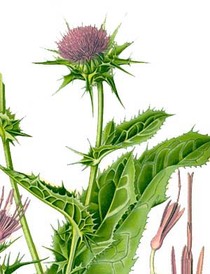 Weed with red purple flowers (Silybum marianum) native to the Mediterranean region. It is related to sunflowers and daisies. It has been used for 2,000 years as an herbal remedy for a variety of ailments, particularly liver, kidney, and gall bladder problems. Several scientific studies suggest that substances in milk thistle (especially a flavonoid called silymarin) protect the liver from toxins, including drugs, such as acetaminophen (Tylenol), which can cause liver damage in high doses. It may have antioxidant and anti-inflammatory properties, protecting against cancer, diabetes and high cholesterol. Milk thistle is generally regarded as safe. It can sometimes act as a laxative, leading to diarrhea and minor stomach issues, such as bloating, nausea, flatulence and lack of appetite. People with a history of hormone-related cancers, including breast, uterine, and prostate cancer, should not take milk thistle. Neither should those allergic to ragweed, chrysanthemums, marigolds, chamomile, yarrow, or daisies. Milk thistle may interfere with the following medications, because both milk thistle and these medications are broken down by the same liver enzymes:
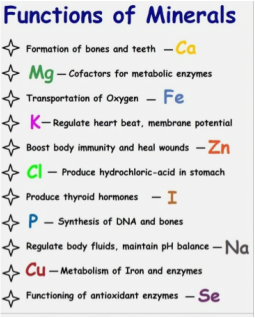 naturally occurring inorganic compounds with a crystal structure. Calcium (dairy and green leafy vegetables), Chloride (salt, soy sauce) Chromium (liver, whole grains, nuts, cheeses) Iron (red meat, spinach), Magnesium (nuts, soybeans, cocoa, whole grains), Phosphorus (seafood, nuts and seeds), Potassium (legumes, whole grains, bananas), Selenium (nuts, especially if from Nebraska or Dakotas, seafood), Sodium (salt, milk, spinach), Sulfur (meats, poultry, fish, eggs, milk, legumes, nuts) Zinc (meats, fish, poultry, whole grains, veggies) and others  Water from a naturally occurring spring overflowing onto the land surface, containing various minerals, such as salts )of calcium, magnesium, sodium), alkali, and sulfur compounds. Mineral water may be fizzy )("effervescent" or "sparkling") due to contained gases. The quality of water discharged by springs can vary greatly because of factors such as the quality of the water. Some commercial mineral water is artificial ("synthetic") prepared in the lab. 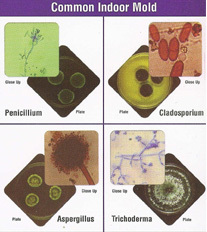 Molds are forms of fungi that can be found almost anywhere, indoors and outdoors. They can grow on virtually any organic substance, as long as moisture and oxygen are present. There are molds that can grow on wood, paper, carpet, foods, and insulation. Different types of mold - black, green, white and orange mold, toxic mold, allergenic mold - are present all the time around us and in the air we breathe. Molds can appear fuzzy or in slimy streaks. The most common indoor molds are Cladosporium (textiles and dump materials), Penicillum (wallpaper, decaying fabrics, carpet, and fiberglass duct insulation), Aspergillus (house dust) Penicillium, Aspergillus (house dust), and Alternaria. commonly found inside nose, mouth and upper respiratory tract . It can cause allergic responses. Molds are associated with musty or earthy odors. In low levels, molds and mold spores are generally harmless but if their levels increase they can affect people; especially people with allergies, asthma and respiratory conditions or suppressed immune system.  Coronary vasodilator and an antianginal drug. Molsidomine is a long acting vasodilator that is metabolized in the liver to the active metabolite linsidomine. Linsidomine is an unstable compound that releases nitric oxide (NO) upon decay as the actual vasodilating compound. The drug attracted attention in the 80s and is used for treatment and prevention of angina pectoris attacks, and for treatment of chronic heart failure, revention of ischemic neurological deficits and delayed brain infarction.  relatively long lasting state of mind or feeling. Moods differ from simple emotions in that they are less specific, less intense, and less likely to be triggered by a particular stimulus or event. Mood can last for one or two days, while emotions can come and go relatively quickly. Moods have two main dimensions— positive affect and negative affect consisting of positive emotions such as excitement, self-assurance, and cheerfulness at the high end, and boredom, sluggishness, and tiredness at the low end; and negative nervousness, stress, and anxiety at the high end, and relaxation, tranquility, and poise at the low end. |
Categories
All
|
